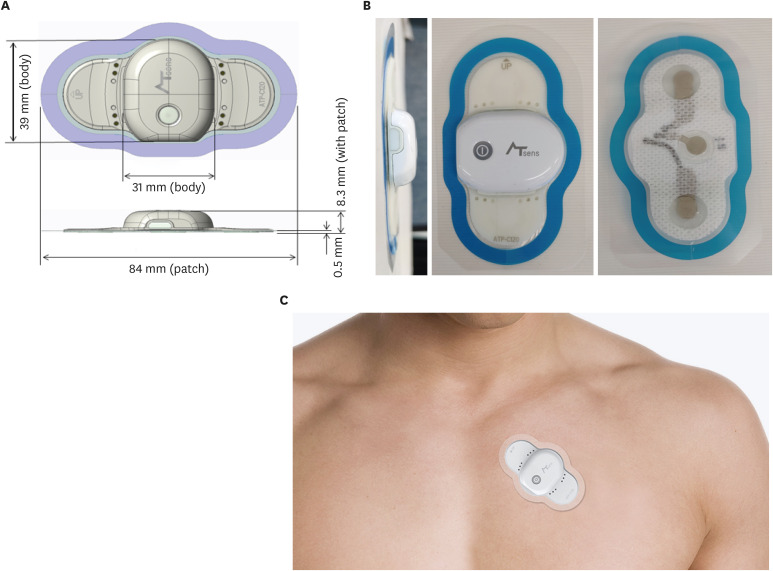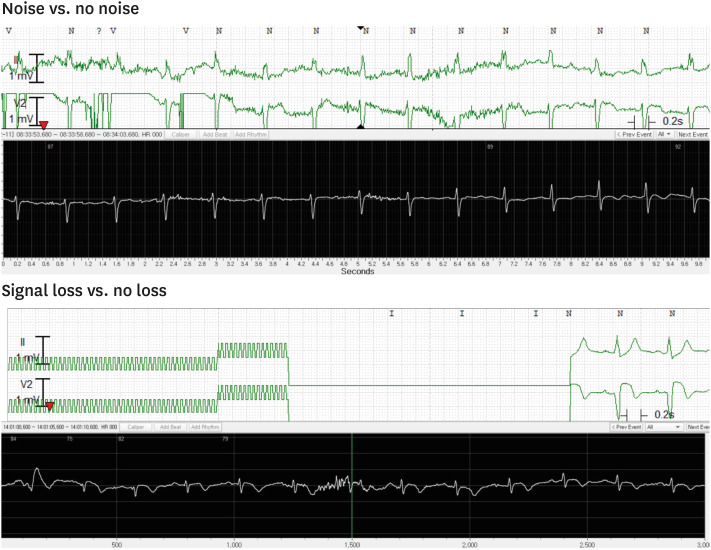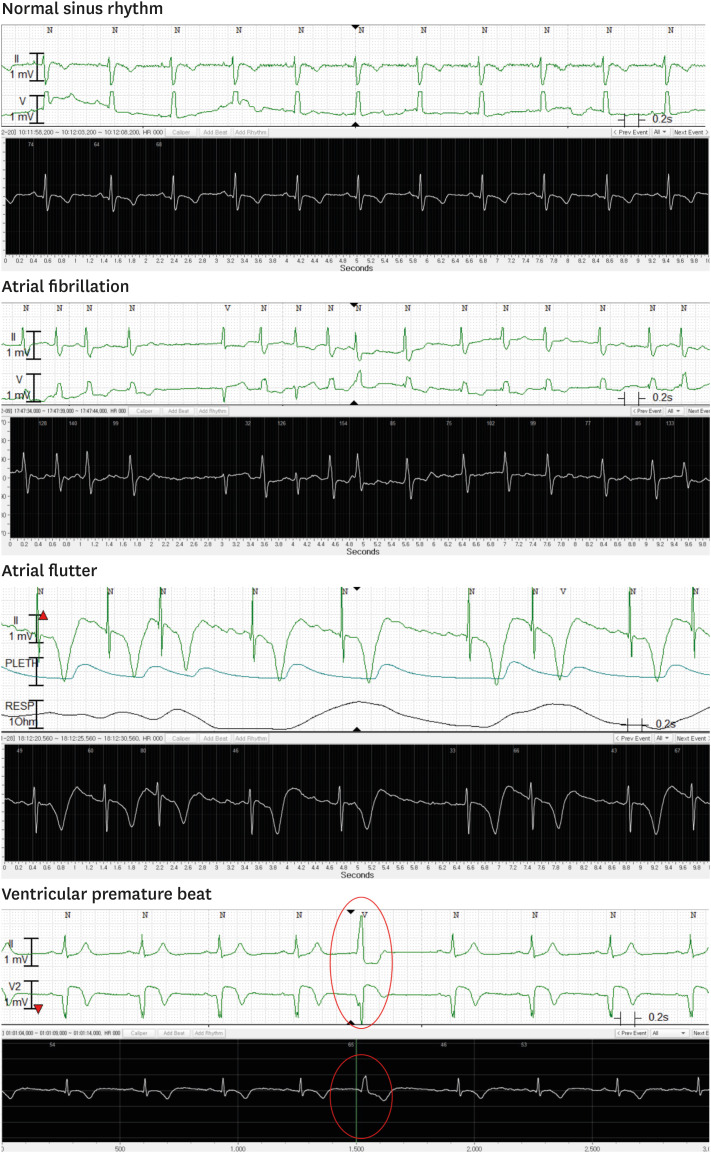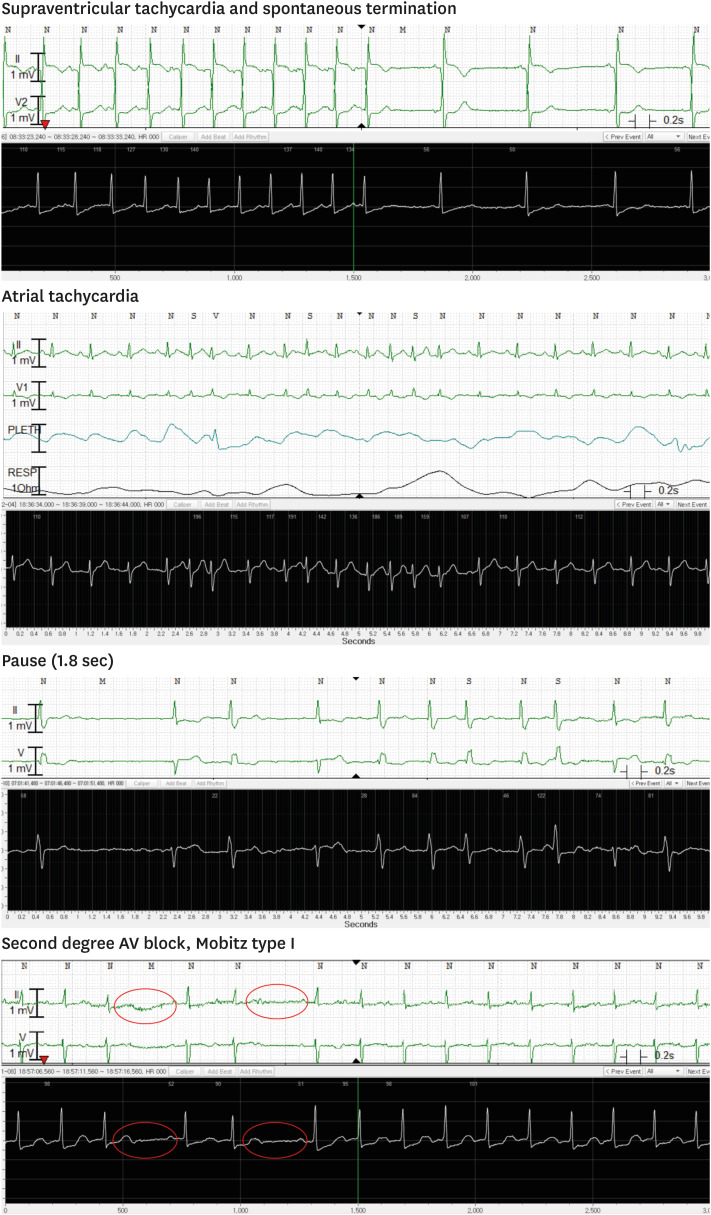J Korean Med Sci.
2020 Nov;35(44):e363. 10.3346/jkms.2020.35.e363.
Comparison of Continuous ECG Monitoring by Wearable Patch Device and Conventional Telemonitoring Device
- Affiliations
-
- 1Cardiovascular Center, Department of Internal Medicine, Seoul National University Bundang Hospital, Seongnam, Korea
- KMID: 2508764
- DOI: http://doi.org/10.3346/jkms.2020.35.e363
Abstract
- Background
Detection of arrhythmias is crucial for the treatment of cardiovascular diseases. However, conventional devices do not provide sufficient diagnostic accuracy while patients should suffer from bothersome diagnostic process. We sought to evaluate diagnostic capability and safety of the new adhesive electrocardiogram (ECG) monitoring device in patients who need ECG monitoring during admission.
Methods
We enrolled 10 patients who admitted to Seoul National University Bundang Hospital and required continuous ECG monitoring between October 31, 2019 and December 18, 2019. New adhesive ECG monitoring device and conventional ECG monitoring device were simultaneously applied to the patients and maintained for 48 hours. From each patient, 48 pairs of ECG signal were collected and analyzed by two cardiologists independently. Discrepancy of diagnosis and frequency of noise or signal loss were compared between the two devices.
Results
From analyzable ECG data, discrepancy of arrhythmia diagnosis was not observed between the two devices. Noise rate was higher in conventional ECG monitoring device (2.5% vs. 17.3%, P < 0.001) and signal loss was not observed in new adhesive device while there was 9.4% of signal losses in conventional Holter recorder group. The new device was well-tolerated among 48 hours of monitoring period and no adverse event was observed.
Conclusion
A newer adhesive ECG monitoring device demonstrated similar diagnostic accuracy compared to conventional ECG monitoring device.
Keyword
Figure
Reference
-
1. Waks JW, Buxton AE. Risk stratification for sudden cardiac death after myocardial infarction. Annu Rev Med. 2018; 69(1):147–164. PMID: 29414264.
Article2. Ibanez B, James S, Agewall S, Antunes MJ, Bucciarelli-Ducci C, Bueno H, et al. 2017 ESC Guidelines for the management of acute myocardial infarction in patients presenting with ST-segment elevation: The Task Force for the management of acute myocardial infarction in patients presenting with ST-segment elevation of the European Society of Cardiology (ESC). Eur Heart J. 2018; 39(2):119–177. PMID: 28886621.3. Zimetbaum P, Goldman A. Ambulatory arrhythmia monitoring: choosing the right device. Circulation. 2010; 122(16):1629–1636. PMID: 20956237.4. Hwang J, Kim J, Choi KJ, Cho MS, Nam GB, Kim YH. Assessing accuracy of wrist-worn wearable devices in measurement of paroxysmal supraventricular tachycardia heart rate. Korean Circ J. 2019; 49(5):437–445. PMID: 30808083.
Article5. Yenikomshian M, Jarvis J, Patton C, Yee C, Mortimer R, Birnbaum H, et al. Cardiac arrhythmia detection outcomes among patients monitored with the Zio patch system: a systematic literature review. Curr Med Res Opin. 2019; 35(10):1659–1670. PMID: 31045463.
Article6. Walsh JA 3rd, Topol EJ, Steinhubl SR. Novel wireless devices for cardiac monitoring. Circulation. 2014; 130(7):573–581. PMID: 25114186.
Article7. Lau JK, Lowres N, Neubeck L, Brieger DB, Sy RW, Galloway CD, et al. iPhone ECG application for community screening to detect silent atrial fibrillation: a novel technology to prevent stroke. Int J Cardiol. 2013; 165(1):193–194. PMID: 23465249.
Article8. Seshadri DR, Bittel B, Browsky D, Houghtaling P, Drummond CK, Desai M, et al. Accuracy of the Apple watch 4 to measure heart rate in patients with atrial fibrillation. IEEE J Transl Eng Health Med. 2019; 8:2700204. PMID: 32128290.
Article9. Gladstone DJ, Spring M, Dorian P, Panzov V, Thorpe KE, Hall J, et al. Atrial fibrillation in patients with cryptogenic stroke. N Engl J Med. 2014; 370(26):2467–2477. PMID: 24963566.
Article10. Healey JS, Connolly SJ, Gold MR, Israel CW, Van Gelder IC, Capucci A, et al. Subclinical atrial fibrillation and the risk of stroke. N Engl J Med. 2012; 366(2):120–129. PMID: 22236222.
Article11. Sanna T, Diener HC, Passman RS, Di Lazzaro V, Bernstein RA, Morillo CA, et al. Cryptogenic stroke and underlying atrial fibrillation. N Engl J Med. 2014; 370(26):2478–2486. PMID: 24963567.
Article12. Go AS, Reynolds K, Yang J, Gupta N, Lenane J, Sung SH, et al. Association of burden of atrial fibrillation with risk of ischemic stroke in adults with paroxysmal atrial fibrillation: the KP-RHYTHM study. JAMA Cardiol. 2018; 3(7):601–608. PMID: 29799942.13. Chen LY, Chung MK, Allen LA, Ezekowitz M, Furie KL, McCabe P, et al. Atrial fibrillation burden: moving beyond atrial fibrillation as a binary entity: a scientific statement from the American Heart Association. Circulation. 2018; 137(20):e623–44. PMID: 29661944.
Article14. Denes P, Gillis AM, Pawitan Y, Kammerling JM, Wilhelmsen L, Salerno DM, et al. Prevalence, characteristics and significance of ventricular premature complexes and ventricular tachycardia detected by 24-hour continuous electrocardiographic recording in the Cardiac Arrhythmia Suppression Trial. Am J Cardiol. 1991; 68(9):887–896. PMID: 1718158.
Article15. Desteghe L, Raymaekers Z, Lutin M, Vijgen J, Dilling-Boer D, Koopman P, et al. Performance of handheld electrocardiogram devices to detect atrial fibrillation in a cardiology and geriatric ward setting. Europace. 2017; 19(1):29–39. PMID: 26893496.
Article16. Bumgarner JM, Lambert CT, Hussein AA, Cantillon DJ, Baranowski B, Wolski K, et al. Smartwatch algorithm for automated detection of atrial fibrillation. J Am Coll Cardiol. 2018; 71(21):2381–2388. PMID: 29535065.17. Haberman ZC, Jahn RT, Bose R, Tun H, Shinbane JS, Doshi RN, et al. Wireless smartphone ECG enables large-scale screening in diverse populations. J Cardiovasc Electrophysiol. 2015; 26(5):520–526. PMID: 25651872.
Article18. Schreiber D, Sattar A, Drigalla D, Higgins S. Ambulatory cardiac monitoring for discharged emergency department patients with possible cardiac arrhythmias. West J Emerg Med. 2014; 15(2):194–198. PMID: 24672611.
Article19. Barrett PM, Komatireddy R, Haaser S, Topol S, Sheard J, Encinas J, et al. Comparison of 24-hour Holter monitoring with 14-day novel adhesive patch electrocardiographic monitoring. Am J Med. 2014; 127(1):95.e11–95.e17.
Article
- Full Text Links
- Actions
-
Cited
- CITED
-
- Close
- Share
- Similar articles
-
- Evaluation of the Diagnostic Performance and Efficacy of Wearable Electrocardiogram Monitoring for Arrhythmia Detection after Cardiac Surgery
- Comparison of Novel Telemonitoring System Using the Single-lead Electrocardiogram Patch With Conventional Telemetry System
- Development of a Wearable Pulse Transit Time Monitoring Device
- Can Fitness Trackers Track Sleep?
- Introduction of Wearable Device in Cardiovascular Field for Monitoring Arrhythmia





